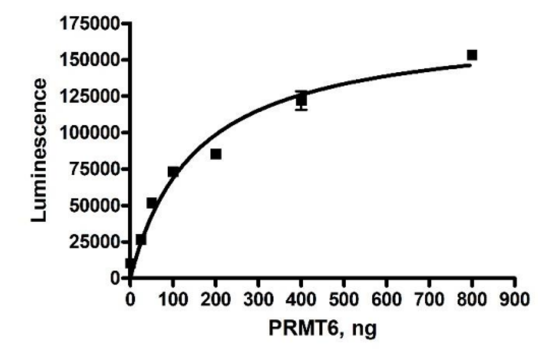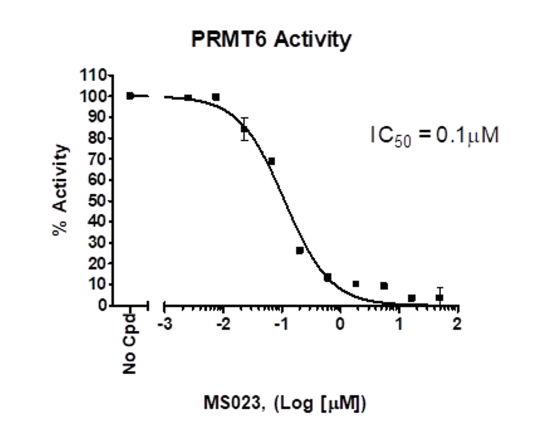PRMT6, His-tag Recombinant
Catalog #
51049
$330
*
●
●
Purchase
Description
Human PRMT6 also known as HRMT1L6 and protein arginine N-methyltransferase 6, GenBank Accession No. NM_018137, a.a. 2-375(end), with N-terminal His-tag, expressed in an E. coli expression system. MW=43 kDa.
This product has been cited 1 time.
●
Synonyms
PRMT6, HRMT1L6, protein arginine N-methyltransferase 6, PRMT-6
●
Product Data Gallery
Product Info
Storage and Usage
Citations1
Species
Human
Host Species/Expression System
E. coli
Purity
≥41%
Supplied As
Aqueous buffer solution.
Formulation
40 mM Tris-HCl, pH 8.0, 110 mM NaCl, 2.2 mM KCl, 200 mM imidazole, 20% glycerol, and 3 mM DTT.
MW
43 kDa
Amino Acids
2–375(end)
Specific Activity
0.036 pmol/min/μg
Genbank #
NM_018137
UniProt #
Q96LA8
Background
Arginine methyltransferase that can both catalyze the formation of monomethylarginine (MMA) and asymmetrical dimethylarginine (aDMA), with a strong preference for the formation of aDMA. Preferentially methylates arginyl residues present in a glycine and arginine-rich domain and displays preference for monomethylated substrates. Specifically mediates the asymmetric dimethylation of histone H3 Arg-2 to form H3R2me2a. H3R2me2a represents a specific tag for epigenetic transcriptional repression and is mutually exclusive with methylation on histone H3 Lys-4 (H3K4me2 and H3K4me3). It thereby acts as a transcription corepressor of various genes such as HOXA2. Also methylates histone H2A and H4 Arg-3 (H2AR3me and H4R3me, respectively). Acts as a regulator of DNA base excision during DNA repair by mediating the methylation of DNA polymerase beta (POLB), leading to stimulate the polymerase activity by enhancing DNA binding and processivity. Methylates HMGA1. May play a role in innate immunity against HIV-1 in case of infection by methylating and impairing the function of various HIV-1 proteins such as Tat, Rev and Nucleocapsid protein p7 (NC).
References
1. Hyllus D. et al., J. Genes Dev. 21(24), 3369-3380 (2007).
2. Guccione E. et al., Nature 449(7164), 933-937 (2007).




